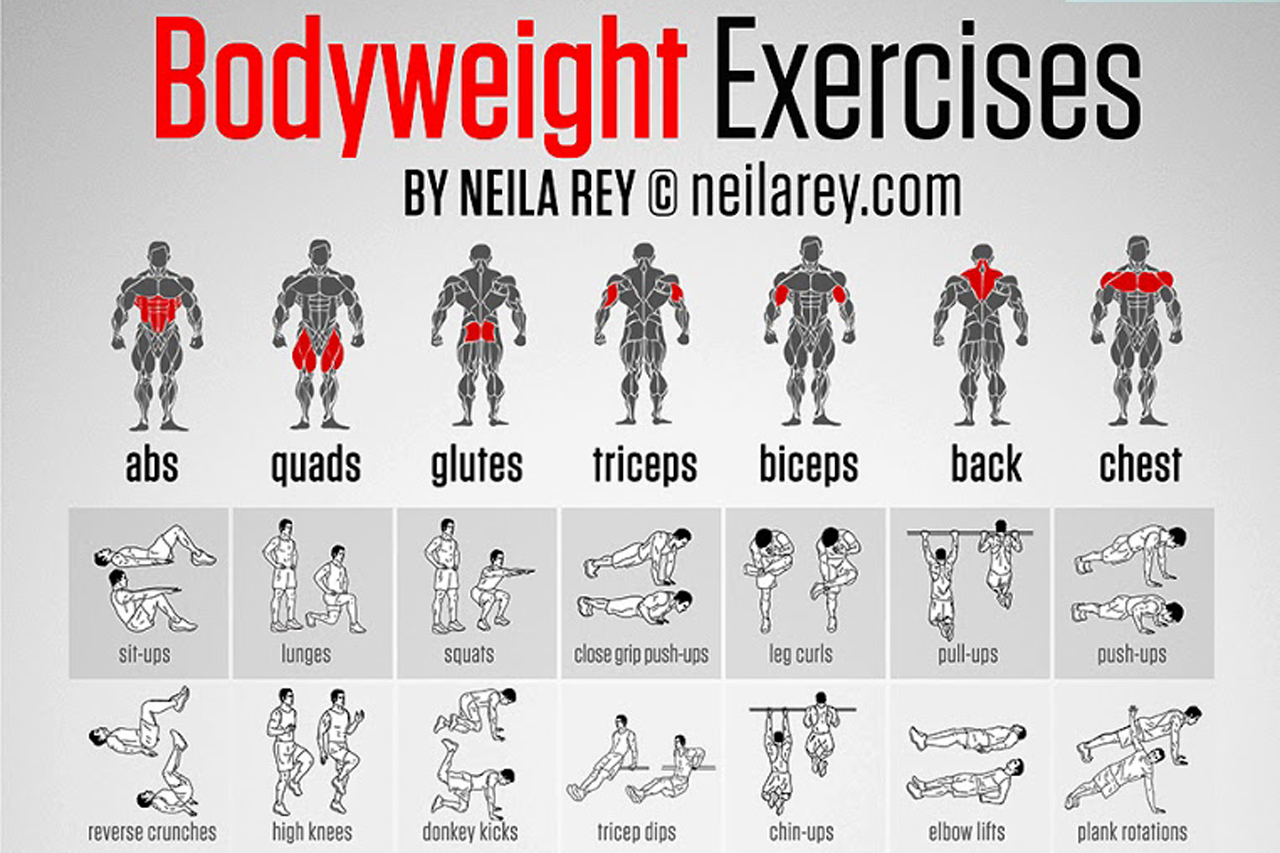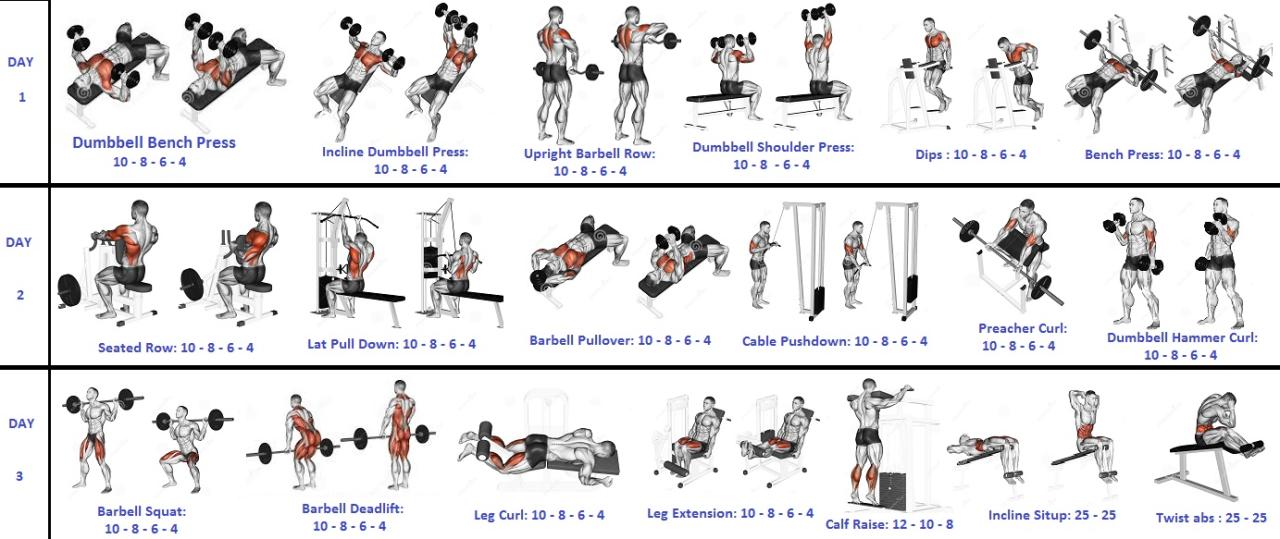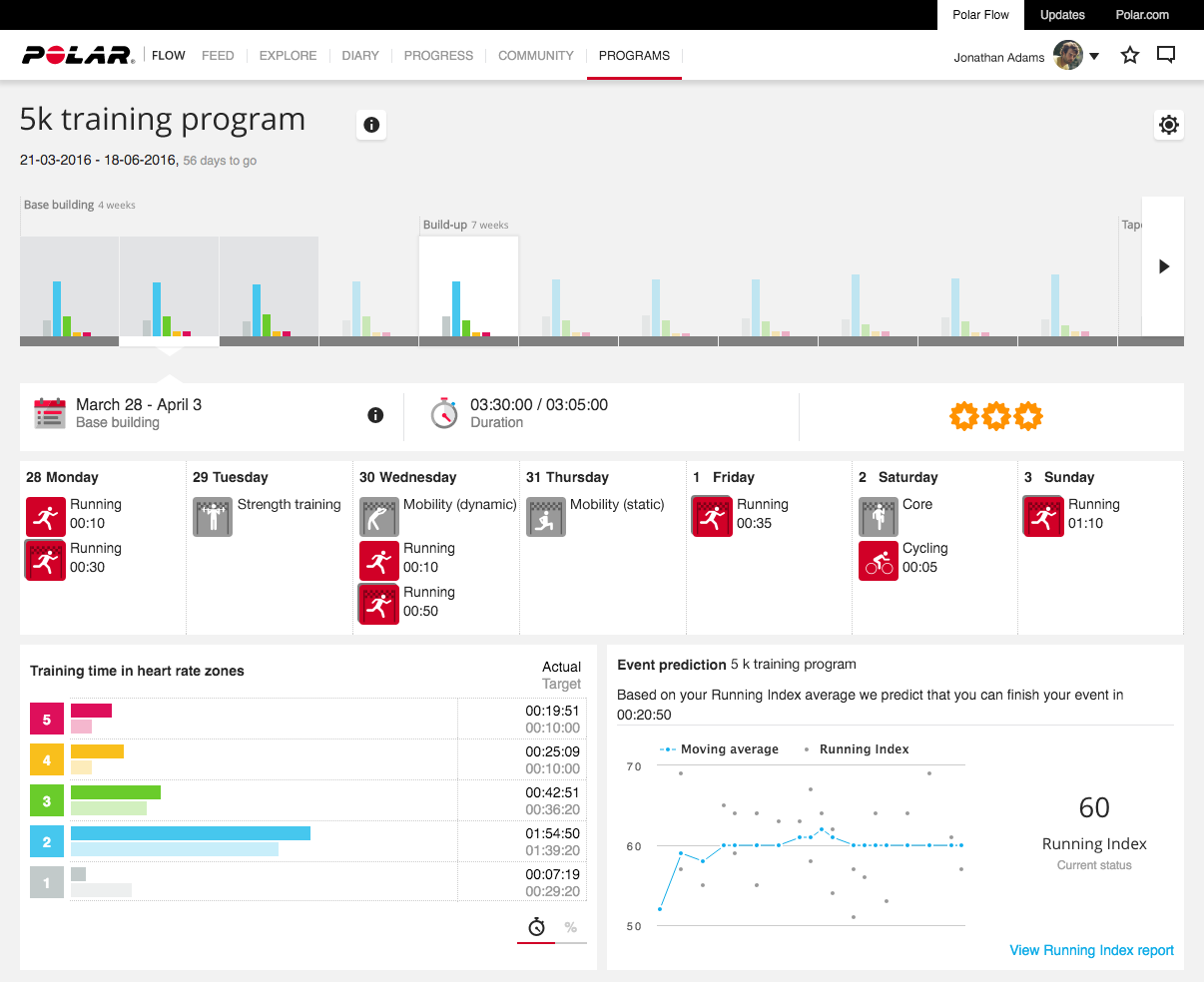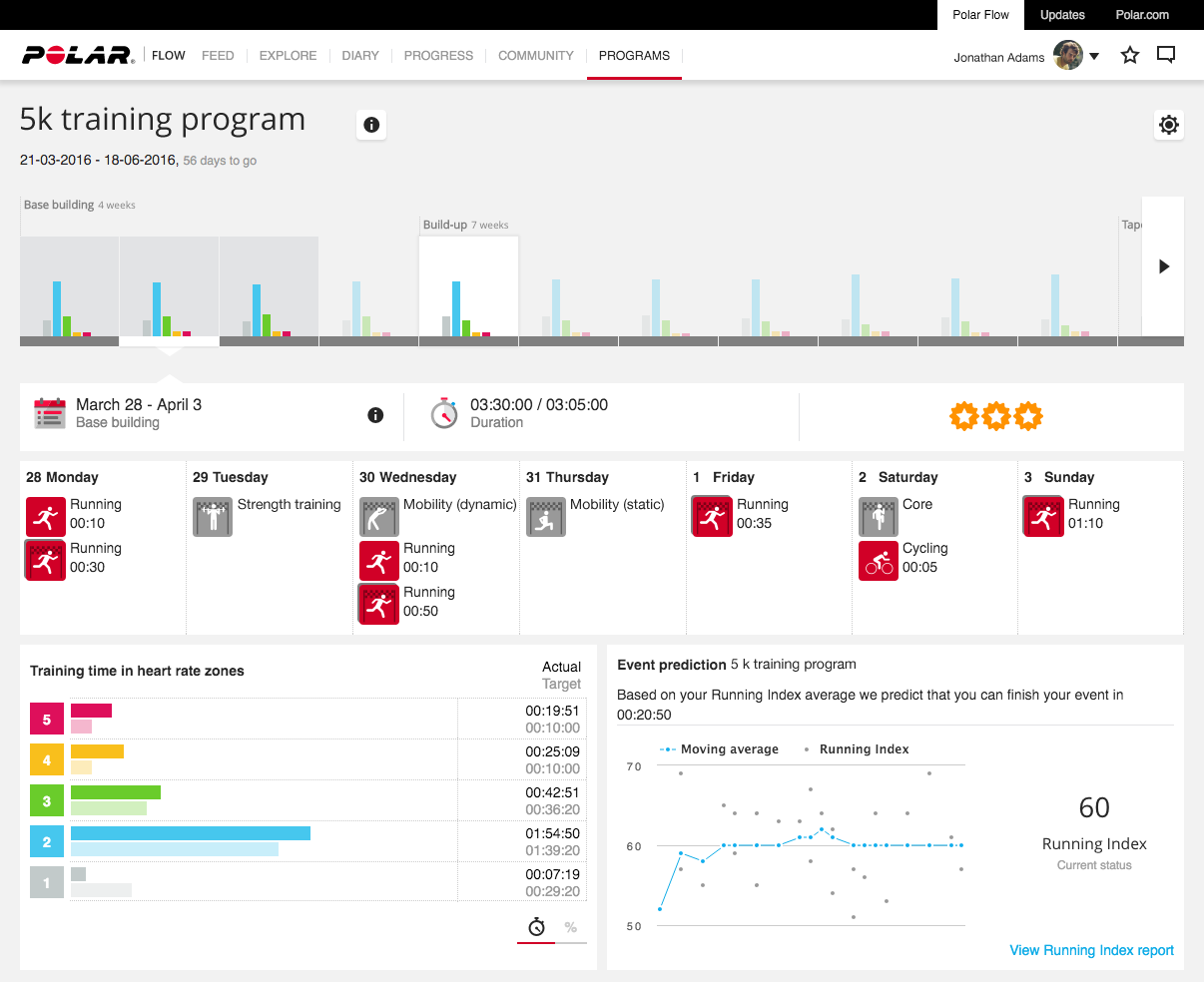Complete Weight Training Workout Plan for Strength and Muscle Gain: Prepare to embark on a muscle-building odyssey! This isn’t your grandpappy’s weightlifting routine; we’re talking sculpted physiques, Herculean strength, and maybe even the ability to bench-press a small car (don’t actually try that last one). We’ll guide you through a 12-week program tailored to your level, from newbie gains to advanced gains-ville.
Get ready to unleash your inner Arnold (minus the questionable political opinions, of course).
This plan isn’t just a list of exercises; it’s a strategic roadmap to transforming your body. We’ll cover everything from proper form (crucial for avoiding injury and maximizing results) to nutrition (because you can’t build a skyscraper on a foundation of stale crackers). We’ll also delve into the science behind muscle growth, ensuring you understand the
-why* behind the
-how*, so you can conquer your fitness goals with knowledge and confidence.
Think of us as your personal fitness Sherpas, guiding you up the mountain of muscle.
Introduction to Weight Training for Strength and Muscle Gain

So, you want to sculpt yourself into a magnificent specimen of human strength and muscle? Excellent choice! Weight training isn’t just about looking good (though that’s a definite perk); it’s about becoming stronger, healthier, and more resilient. This isn’t some fleeting fad; it’s a journey of self-improvement that can yield incredible results, both physically and mentally. Get ready to embark on an adventure where iron becomes your friend and sweat your reward!Weight training fundamentally alters your body’s composition, boosting both strength and muscle mass.
This happens through a process called muscle hypertrophy, where your muscles literally grow larger in response to the stress of lifting weights. Simultaneously, your nervous system adapts, improving its ability to recruit muscle fibers, leading to significant strength gains. This isn’t just about adding more weight to the bar; it’s about systematically challenging your muscles, pushing them beyond their comfort zone, and allowing them to recover and rebuild stronger than before.
Muscle Hypertrophy and Strength Development
Muscle hypertrophy, the increase in muscle size, occurs when the muscle fibers experience microscopic tears during weight training. These tears, while sounding scary, are a crucial part of the process. During recovery, the body repairs these tears, resulting in the growth of new muscle protein and an increase in muscle fiber size. This growth is stimulated by a combination of mechanical tension (the force placed on the muscle), metabolic stress (the buildup of metabolic byproducts during exercise), and muscle damage (those aforementioned microscopic tears).
Find out further about the benefits of weight training program for men to build muscle and lose fat that can provide significant benefits.
Strength development, on the other hand, is influenced by both muscle size and the nervous system’s efficiency in recruiting and coordinating muscle fibers. Think of it like this: a bigger engine (larger muscles) is great, but a finely-tuned engine (efficient nervous system) will get you to your destination faster.
Progressive Overload in Weight Training
Progressive overload is the cornerstone of any successful weight training program. It simply means consistently increasing the demands placed on your muscles over time. This can be achieved by gradually increasing the weight lifted, the number of repetitions performed, or the number of sets completed. For example, if you can bench press 100 pounds for 8 repetitions, progressive overload might involve increasing the weight to 105 pounds next week, maintaining the 8 repetitions.
Alternatively, you could maintain the weight and aim for 10 repetitions. Failing to progressively overload your muscles will eventually lead to a plateau, where your progress stagnates. It’s like challenging your muscles to a never-ending game of “keep-up.” The key is to find the sweet spot where you’re constantly challenging yourself without risking injury. Listen to your body, and remember that consistency and smart progression are far more important than lifting excessively heavy weights too soon.
Designing a Complete Workout Plan
So, you’ve decided to embark on the glorious journey of weight training – congratulations! Now comes the fun part: crafting a workout plan that’s as effective as it is entertaining (because let’s face it, grunting under heavy weight can be surprisingly amusing). This section will guide you through designing a plan tailored to your experience level, ensuring you build strength, gain muscle, and maybe even develop a charmingly competitive streak.
A 12-Week Weight Training Program
This sample 12-week program incorporates different training splits to prevent boredom and target muscle groups effectively. Remember, consistency is key! Don’t be afraid to adjust the weights and reps based on your individual progress. This isn’t a one-size-fits-all solution; it’s a template to build upon.
| Week | Training Split | Focus |
|---|---|---|
| 1-4 | Upper/Lower | Building a foundation; focusing on proper form. |
| 5-8 | Push/Pull/Legs | Increasing volume and intensity. Introduction of supersets. |
| 9-12 | Full Body (3x/week) | Advanced techniques; incorporating drop sets and manipulating training variables. |
Beginner Weight Training Plan
For beginners, the emphasis is on mastering proper form and technique before focusing on heavy weights. This prevents injuries and lays the groundwork for long-term success. Think of this as learning the alphabet before writing a novel.
A sample beginner’s workout (3 days/week, with rest days in between):
- Day 1: Upper Body
-Bench Press (3 sets of 8-12 reps), Overhead Press (3 sets of 8-12 reps), Bent-Over Rows (3 sets of 8-12 reps), Bicep Curls (3 sets of 10-15 reps), Triceps Extensions (3 sets of 10-15 reps). - Day 2: Lower Body
-Squats (3 sets of 8-12 reps), Deadlifts (1 set of 5 reps, 1 set of 3 reps, 1 set of 1 rep – focus on form!), Lunges (3 sets of 10-12 reps per leg), Calf Raises (3 sets of 15-20 reps). - Day 3: Core & Rest
-Planks (3 sets, hold for 30-60 seconds), Crunches (3 sets of 15-20 reps), Russian Twists (3 sets of 15-20 reps per side). Rest and recover!
Intermediate Weight Training Plan
Intermediate lifters can benefit from incorporating advanced training techniques like supersets (performing two exercises back-to-back without rest) and drop sets (immediately reducing the weight and continuing the exercise). This increases intensity and challenges the muscles further. Think of it as adding spices to your already delicious workout recipe.
A sample intermediate workout (4 days/week, using a push/pull/legs split):
- Day 1: Push
-Bench Press (3 sets of 6-8 reps), Incline Dumbbell Press (3 sets of 8-12 reps), Overhead Press (3 sets of 8-12 reps) – Superset the last two exercises. - Day 2: Pull
-Pull-ups (3 sets to failure), Bent-Over Rows (3 sets of 6-8 reps), Lat Pulldowns (3 sets of 8-12 reps) – Perform a drop set on the last set of Bent-Over Rows. - Day 3: Legs
-Squats (3 sets of 6-8 reps), Romanian Deadlifts (3 sets of 8-12 reps), Leg Press (3 sets of 10-15 reps). - Day 4: Rest or Active Recovery – Light cardio, stretching, or foam rolling.
Advanced Weight Training Plan
Advanced lifters focus on manipulating training variables like intensity (weight used), volume (sets and reps), and rest periods to continuously challenge their bodies. This requires a deep understanding of your own capabilities and a willingness to experiment (safely, of course!). This is where the real artistry of weight training comes in.
A sample advanced workout (5 days/week, utilizing a full-body approach with varying rep ranges and rest periods):
- Day 1: Full Body (Heavy)
-Squats (3 sets of 3-5 reps), Bench Press (3 sets of 3-5 reps), Deadlifts (1 set of 5 reps, 1 set of 3 reps, 1 set of 1 rep). - Day 2: Full Body (Moderate)
-Overhead Press (3 sets of 6-8 reps), Bent-Over Rows (3 sets of 6-8 reps), Lunges (3 sets of 8-12 reps per leg). - Day 3: Rest
- Day 4: Full Body (High Volume)
– Incline Dumbbell Press (4 sets of 10-15 reps), Pull-ups (4 sets to failure), Leg Press (4 sets of 12-15 reps). - Day 5: Full Body (Moderate Intensity)
-Focus on accessory exercises and core work.
Exercise Selection and Execution

Choosing the right exercises and executing them with perfect form is the cornerstone of a successful strength and muscle-building program. Think of it like this: you wouldn’t try to build a skyscraper on a shaky foundation, would you? Similarly, sloppy form can lead to injury and hinder your progress. This section will guide you through selecting effective exercises and mastering their execution.
Compound Exercises for Strength and Muscle Mass
Compound exercises, which work multiple muscle groups simultaneously, are the heavy hitters in any strength training program. They’re incredibly efficient for building overall strength and muscle mass, saving you time and maximizing your results. Remember, proper form is paramount to avoid injury and maximize muscle activation.
| Exercise Name | Muscle Group Targeted | Sets | Reps |
|---|---|---|---|
| Squats | Quads, Glutes, Hamstrings, Core | 3-4 | 8-12 |
| Bench Press | Chest, Shoulders, Triceps | 3-4 | 8-12 |
| Deadlifts | Back, Glutes, Hamstrings, Traps | 1-3 | 5-8 |
| Overhead Press | Shoulders, Triceps | 3-4 | 8-12 |
| Bent-Over Rows | Back, Biceps, Forearms | 3-4 | 8-12 |
Proper Form and Technique for Compound Exercises
Let’s break down the proper form for each of these exercises. Imagine yourself as a superhero meticulously crafting your physique. Precision is key! Squats: Stand with feet shoulder-width apart, toes slightly outward. Lower your hips as if sitting in a chair, keeping your back straight and chest up. Your knees should track over your toes.
Push through your heels to return to the starting position. Visualize a straight line from your head to your heels throughout the movement. Bench Press: Lie on a bench with feet flat on the floor. Grip the bar slightly wider than shoulder-width apart. Lower the bar to your chest, keeping your elbows slightly bent.
Push the bar back up to the starting position, maintaining a controlled movement. Imagine pushing the bar away from your chest with your entire body. Deadlifts: Stand with feet hip-width apart, the bar over your mid-foot. Bend at your hips and knees, keeping your back straight and your core engaged. Grab the bar with an overhand grip, slightly wider than shoulder-width.
Lift the bar by extending your hips and knees simultaneously, maintaining a straight back. Think of pulling the weight up your legs, not your back. Overhead Press: Stand with feet shoulder-width apart, holding a barbell at shoulder height. Press the bar straight overhead, keeping your core engaged and your back straight. Slowly lower the bar back to the starting position.
Visualize pushing the weight straight up, without leaning or swaying. Bent-Over Rows: Stand with feet shoulder-width apart, holding a barbell in front of you. Bend at your hips, keeping your back straight and your core engaged. Pull the bar towards your chest, squeezing your shoulder blades together. Slowly lower the bar back to the starting position.
Focus on pulling the weight with your back muscles, not your arms.
Discover more by delving into strength exercises for weight loss and muscle toning further.
Isolation Exercises for Specific Muscle Groups
After hitting the major muscle groups with compound exercises, isolation exercises allow you to focus on specific areas for further development and shaping. Think of them as the finishing touches on your masterpiece.* Bicep Curls: Focus on controlled movements, avoiding momentum.
Triceps Extensions
Maintain tension throughout the exercise.
Lateral Raises
Control the weight and avoid swinging.
Calf Raises
Concentrate on the squeeze at the top of the movement.
Hamstring Curls
Maintain a slow, controlled tempo.
Discover how best weight lifting program for women to build strength and tone has transformed methods in this topic.
Warm-up and Cool-down Routines
Never underestimate the importance of warm-up and cool-down routines! A proper warm-up prepares your body for the workout, reducing the risk of injury and improving performance. A cool-down helps your body recover and reduces muscle soreness.A good warm-up might include 5-10 minutes of light cardio, followed by dynamic stretching like arm circles and leg swings. A cool-down should include 5-10 minutes of light cardio and static stretching, holding each stretch for 20-30 seconds.
Think of it as prepping your engine before a race and letting it cool down afterward.
Nutrition and Recovery: Complete Weight Training Workout Plan For Strength And Muscle Gain

Fueling your body like a finely-tuned sports car is crucial for building serious strength and muscle. Think of your muscles as ambitious construction workers – they need the right materials (food!) and enough rest to build that impressive physique you’re aiming for. Neglecting this vital aspect is like trying to build a skyscraper with toothpicks and wishful thinking. It simply won’t work.Proper nutrition is the cornerstone of muscle growth and recovery.
Without sufficient nutrients, your workouts become a frustrating exercise in futility. Your body needs the building blocks to repair muscle tissue damaged during training and to synthesize new muscle protein. This isn’t about getting ripped overnight; it’s about consistently providing your body with the fuel it needs to achieve your goals.
Macronutrient Roles in Muscle Growth
Macronutrients – proteins, carbohydrates, and fats – play distinct but equally important roles in supporting your weight training goals. Protein is the undisputed king of muscle building, providing the amino acids necessary for muscle protein synthesis. Carbohydrates are the primary source of energy, fueling your intense workouts and replenishing glycogen stores (your muscles’ energy reserves). Fats, often unfairly maligned, are crucial for hormone production, cell function, and overall health – vital components of a successful training program.
Ignoring any of these macronutrients will significantly hinder your progress.
Sample Meals and Snacks for Muscle Growth and Recovery
Providing examples of meals and snacks that support muscle growth and recovery is important for practical application of nutritional knowledge. These examples are not exhaustive but represent balanced choices supporting muscle protein synthesis, energy provision, and overall well-being.
- Breakfast: Oatmeal with berries and a scoop of whey protein powder. This provides complex carbohydrates for sustained energy, antioxidants from berries, and fast-digesting protein for muscle repair.
- Lunch: Grilled chicken breast salad with mixed greens, quinoa, and avocado. This meal combines lean protein, healthy fats, and complex carbohydrates for a well-rounded nutrient profile.
- Dinner: Baked salmon with sweet potatoes and broccoli. This offers a good source of omega-3 fatty acids, complex carbohydrates, and micronutrients.
- Snack: Greek yogurt with almonds. This provides a good source of protein and healthy fats to curb hunger and support muscle recovery.
- Post-Workout Snack: Protein shake with banana. This rapidly replenishes glycogen stores and provides easily digestible protein for muscle repair.
Importance of Sleep and Stress Management
Sleep and stress management are often overlooked but are absolutely critical for optimal recovery. Think of sleep as your body’s “muscle-building factory” – it’s where the majority of muscle repair and growth occurs. Insufficient sleep disrupts hormone balance, hindering muscle growth and recovery. Chronic stress elevates cortisol levels, a catabolic hormone that breaks down muscle tissue. Prioritizing sleep (aim for 7-9 hours of quality sleep per night) and implementing stress-reduction techniques like meditation, yoga, or spending time in nature is just as important as your workouts.
Neglecting these aspects will undermine your hard work in the gym.
Tracking Progress and Adjustments
So, you’ve been diligently following your weight training plan, sweating it out like a gladiator in a sauna, and now it’s time for the crucial part: seeing if all that hard work is paying off. Tracking your progress isn’t just about numbers; it’s about understanding your body’s response and making smart adjustments to keep those gains coming. Think of it as a high-tech, muscle-building detective story, where you are the Sherlock Holmes of your own physique.Tracking progress involves more than just hoping your jeans feel a little looser.
We need a systematic approach, a blend of scientific rigor and healthy self-awareness. This means diligently recording your workouts and regularly monitoring changes in your body composition. By meticulously documenting your journey, you’ll gain valuable insights into what works best for you, allowing you to optimize your plan and maximize your results. This isn’t just about numbers; it’s about understanding your body’s individual response to training.
Methods for Tracking Workout Progress
Recording your workouts is as essential as the weights themselves. Imagine trying to navigate a city without a map – chaos! Similarly, without tracking your sets, reps, and weight lifted, you’re essentially training blind. A simple notebook or a dedicated fitness app can be your trusty sidekick in this endeavor. For each exercise, meticulously note the weight used, the number of repetitions completed, and the number of sets performed.
Don’t be shy with the details; the more data you gather, the clearer the picture will become. For example, if you’re doing bench presses, record each session like this: “Bench Press: 135 lbs, 3 sets of 8 reps.” Over time, you’ll see trends – are you consistently increasing weight, reps, or sets? This information is gold!
Monitoring Body Composition Changes
Now, let’s talk about the fun part: measuring your progress beyond just the numbers on the weight plates. Monitoring body composition involves tracking changes in your body weight, body fat percentage, and various body measurements. While a bathroom scale provides a basic overview, measuring your body fat percentage (using calipers, bioelectrical impedance analysis, or DEXA scans) offers a more accurate picture of your progress.
Furthermore, taking regular measurements of your waist, chest, arms, and legs provides a detailed snapshot of muscle growth and fat loss. Remember, consistent monitoring, not just occasional checks, is key. Compare your measurements every 2-4 weeks to observe meaningful changes. If you notice a plateau, it’s time to strategize!
Adjusting the Workout Plan Based on Progress
Your workout plan isn’t set in stone; it’s a living document that should adapt to your progress. If you consistently exceed your targets (e.g., you can easily do more reps or lift heavier weights), it’s time to increase the challenge. This could involve increasing the weight, adding reps, adding sets, or even incorporating more challenging variations of the exercises.
Conversely, if you’re struggling to meet your targets, it might be necessary to reduce the weight, reps, or sets, or focus on improving your form before progressing further. Remember, progress isn’t always linear. There will be weeks where you feel stronger and weeks where you might feel a little weaker. The key is to adapt and adjust accordingly.
Don’t be afraid to experiment and find what works best for you.
Listening to Your Body and Making Necessary Adjustments
This is arguably the most important aspect of tracking progress and adjusting your workout plan. Your body is a complex machine, and it’s crucial to pay attention to its signals. Ignoring pain or persistent fatigue can lead to injuries and hinder your progress. Rest and recovery are essential components of any successful weight training program. If you experience persistent pain, reduce the intensity or volume of your workouts, or even take a day or two off.
Remember, consistency is key, but so is listening to your body’s cues. A well-rested body is a productive body, and sometimes, less is more. Don’t push yourself to the point of injury; smart training is sustainable training.
Safety and Injury Prevention

Lifting weights can be incredibly rewarding, transforming your physique and boosting your confidence. But let’s be honest, flinging heavy metal around isn’t exactly a walk in the park. Avoiding injury is paramount – nobody wants to spend their gains recovering from a pulled muscle or worse. This section will equip you with the knowledge to train smart, stay safe, and keep those gains coming.Proper lifting techniques are the cornerstone of injury prevention.
Think of your body as a finely tuned machine; misuse it, and it’ll break down. Ignoring proper form not only increases your risk of injury but also limits the effectiveness of your workout. You’re not just moving weight; you’re meticulously controlling its movement through a specific range of motion.
Proper Lifting Techniques
Maintaining a neutral spine is crucial. Imagine a straight line running from your head to your tailbone – this is your ideal posture during most lifts. Avoid excessive arching or rounding of your back, which puts undue stress on your vertebrae. For example, during squats, focus on keeping your chest up and your core engaged. Similarly, when performing deadlifts, maintain a flat back throughout the movement, initiating the lift by extending your hips and knees simultaneously.
Never sacrifice form for weight; it’s always better to lift lighter with perfect form than heavier with sloppy technique.
Effective Warm-up and Cool-down Strategies, Complete weight training workout plan for strength and muscle gain
Before you even think about touching a weight, a proper warm-up is essential. This prepares your muscles and joints for the exertion ahead, increasing blood flow and flexibility. A dynamic warm-up, involving movements like arm circles, leg swings, and torso twists, is ideal. Aim for 5-10 minutes of dynamic stretching before each workout. Conversely, a cool-down helps your body gradually return to its resting state, reducing muscle soreness and stiffness.
This involves light cardio, such as slow jogging or cycling, followed by static stretches, holding each stretch for 20-30 seconds. Think of it as unwinding your body after a good workout. For example, after squats, hold a hamstring stretch, gently pulling your leg towards your chest.
Safe Equipment Usage and Workout Environment
Using proper equipment is non-negotiable. Ensure that all weights are securely loaded onto the bars and machines, and that any safety mechanisms are properly engaged. Don’t be a hero; if you’re unsure about a piece of equipment, ask a trainer for assistance. Maintain a clean and organized workout area. Avoid cluttered spaces that could lead to trips and falls.
Proper lighting is also vital for ensuring visibility and avoiding accidents. For instance, make sure you have enough light to see clearly the weight plates and the space around you.
Seeking Professional Guidance
Knowing when to seek professional help is a sign of strength, not weakness. If you experience persistent pain, unusual stiffness, or any injury, don’t hesitate to consult a doctor or physical therapist. They can diagnose the problem and recommend appropriate treatment. Similarly, working with a certified personal trainer can be invaluable, especially when starting out. They can help you develop a safe and effective workout program tailored to your individual needs and abilities, ensuring that you are lifting with the correct form and technique.
They can also spot you on heavy lifts, preventing potential injuries.
Ultimate Conclusion
So there you have it – your ticket to a stronger, more muscular you! Remember, consistency is key. Don’t expect miracles overnight; building a body like a Greek god takes time, dedication, and maybe a few protein shakes. But with this complete weight training workout plan as your guide, you’ll be well on your way to achieving your fitness aspirations.
Now go forth and conquer those weights – and maybe even that small car (again, don’t actually do that!). And remember, always consult with a healthcare professional before starting any new workout routine.
